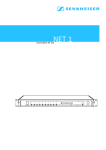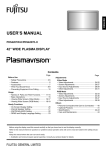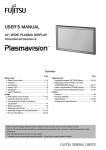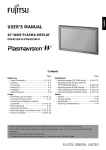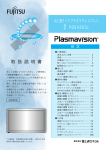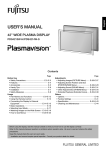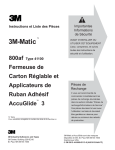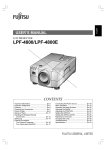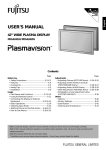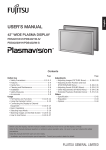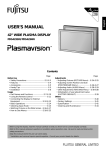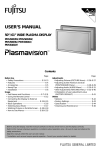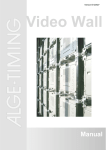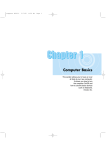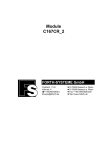Download USER`S MANUAL - fujitsu general
Transcript
ENGLISH USER’S MANUAL PDS4204W-H/PDS4204E-H (WITH PC CARD) 42” WIDE PLASMA DISPLAY Contents Page Before Use • Safety Precautions ·········································· 3-4 • Features ····························································· 5 • Accessories ························································ 6 • What You Should Know ·································· 7-8 • Preventing Equipment from Falling ···················· 9 Usage • Names of Parts and Their Functions ········· 10-13 • Basic Operations·············································· 14 • Using PC Card ············································ 15-19 • Viewing Wide Screen (VIDEO Mode) ········· 20-21 • Viewing Wide Screen (RGB Mode) ············· 22-23 Handy Functions • On-Screen Display Setting ······························· 24 • Internal Speaker Setting ·································· 25 • WHITE BALANCE Setting ······························· 26 • DPMS and Display Language Setting·············· 27 Page Adjustments VIDEO Mode • Video Adjustments ······································· 28-29 • Screen Adjustments ····································· 30-31 • Input Source Adjustments ···························· 32-33 • Other Adjustments ······································· 34-35 RGB Mode • Video Adjustments ······································· 36-37 • Screen Adjustments ····································· 38-39 • Input Source Adjustments ···························· 40-41 • Other Adjustments ······································· 42-43 PC CARD Mode • Video Adjustments ······································· 44-45 • Other Adjustments ······································· 46-47 Others • Personal Computers that Can be Connceted ··· 48 • Optional Products ············································· 49 • Specifications ··············································· 50-51 • Care and Maintenance······································ 52 Before using the display, read this manual carefully so that you know how to use the display correctly. Refer to this manual whenever questions or problems about operation arise. Be sure to read and observe the safety precautions. Keep this manual where the user can see it easily. ∗ Installation and removal require special expertise. Consult your product dealer for details FUJITSU GENERAL LIMITED DECLARATION OF CONFORMITY according to EN45014 We Fujitsu General (Euro) GmbH of Werftstraße 20, D-40549 Düsseldorf, F. R. Germany Manufacturer: Shinjyo Fujitsu General Limited 702-3 Kanezawa Shinjyo-shi Yamagata Japan declares under our sole responsibility that the product, Type: 42” PLASMA DISPLAY Model Name: PDS4204W-H/PDS4204E-H to which this declaration relates are in conformity with the following standards; European Standards: EMC: a. EN55022 1994, Class A b.EN61000-3-2 1995 c. EN61000-3-3 1995 d.EN50082-2 1995 (EN61000-4-2 1995 / EN 61000-4-4 1995 / EN61000-4-8 1993) (ENV50140 1993 / ENV50141 1993 / ENV50204 1995) Safety: e. EN60950 1992/A1:1993/A2:1993) By conformance with the standard referenced, the product follows the provisions of the directives listed below. a. EC b.EC c. EC d.EC Council Council Council Council Directive Directive Directive Directive 89/336/EEC of 3rd, May 1989 92/31/EEC of 28th, April 1992 93/68/EEC of 22nd, July 1993 73/23/EEC of 19th, February 1973 Place of Issue: Germany Date of Issue: Nov. 1997 Signature: H. Hirosaki, Managing Director Fujitsu General (Euro) GmbH Declaration reference: Fujitsu General (Euro) GmbH Werftstraße 20, D-40549 Düsseldorf, F. R. Germany Tel: 0211-50098-0 Fax: 0211-50098-50 2 ENGLISH FCC NOTICE This equipment has been tested and found to comply with the limits for a Class A digital device, pursuant to Part 15 of the FCC Rules. These limits are designed to provide reasonable protection against harmful interference when the equipment is operated in a commercial environment. This equipment generates, uses, and can radiate radio frequency energy and, if not installed and used in accordance with the instruction manual, may cause harmful interference to radio communications. Operation of this equipment in a residential area is likely to cause harmful interference in which case the user will be required to correct the interference at his own expense. IMPORTANT INFORMATION WARNING: This is Class A product. In a domestic environment this product may cause radio interference in which case the user may be required to take adequate measures. WARNING: TO REDUCE THE RISK OF FIRE AND ELECTRIC SHOCK, DO NOT EXPOSE THIS PRODUCT TO RAIN OR MOISTURE. IMPORTANT SAFEGUARDS Electrical energy can perform many useful functions. This unit has been engineered and manufactured to assure your personal safety. But IMPROPER USE CAN RESULT IN POTENTIAL ELECTRICAL SHOCK OR FIRE HAZARD. In order not to defeat the safeguards incorporated into this product, observe the following basic rules for its installation, use and service. Please read these “Important Safeguards” carefully before use. – All the safety and operating instructions should be read before the product is operated. – The safety and operating instructions should be retained for future reference. – All warnings on the product and in the operating instructions should be adhered to. – All operating instructions should be followed. – Unplug this product from the wall outlet before cleaning. Do not use liquid cleaners or aerosol cleaners. Use a damp cloth for cleaning. – Do not use attachments not recommended by the product manufacturer as they may be hazardous. – Do not use this product near water. Do not use immediately after moving from a low temperature to high temperature, as this causes condensation, which may result in fire, electric shock, or other hazards. – Do not place this product on an unstable cart, stand, or table. The product may fall, causing serious injury to a child or adult, and serious damage to the product. The product should be mounted according to the manufacturer’s instructions, and should use a mount recommended by the manufacturer. – When the product is used on a cart, care should be taken to avoid quick stops, excessive force, and uneven surfaces which may cause the product and cart to overturn, damaging equipment or causing possible injury to the operator. – Slots and openings in the cabinet are provided for ventilation. These ensure reliable operation of the product and protect it from overheating. These openings must not be blocked or covered. (The openings should never be blocked by placing the product on bed, sofa, rug, or similar surface. It should not be placed in a built-in installation such as a bookcase or rack unless proper ventilation is provided and the manufacturer’s instructions have been adhered to.) For proper ventilation, separate the product from other equipment, which may prevent ventilation and keep distance more than 10cm. 3 SAFETY PRECAUTIONS – This product should be operated only with the type of power source indicated on the label. If you are not sure of the type of power supply to your home, consult your product dealer or local power company. – This product is equipped with a three-wire plug. This plug will fit only into a grounded power outlet. If you are unable to insert the plug into the outlet, contact your electrician to install the proper outlet. Do not defeat the safety purpose of the grounded plug. – Power-supply cords should be routed so that they are not likely to be walked on or pinched by items placed upon or against them. Pay particular attention to cords at doors, plugs, receptacles, and the point where they exit from the product. – For added protection of this product during a lightning storm, or when it is left unattended and unused for long periods of time, unplug it from the wall outlet and disconnect the cable system. This will prevent damage to the product due to lightning and power line surges. – Do not overload wall outlets, extension cords, or convenience receptacles on other equipment as this can result in a risk of fire or electric shock. – Never push objects of any kind into this product through openings as they may touch dangerous voltage points or short out parts that could result in a fire or electric shock. Never spill liquid of any kind on the product. – Do not attempt to service this product yourself as opening or removing covers may expose you to dangerous voltages and other hazards. Refer all service to qualified service personnel. – Unplug this product from the wall outlet and refer service to qualified service personnel under the following conditions: a) When the power supply cord or plug is damaged. b) If liquid has been spilled, or objects have fallen on the product. c) If the product has been exposed to rain or water. d) If the product does not operate normally by following the operating instructions. Adjust only those controls that are covered by the Operation Manual, as an improper adjustment of other controls may result in damage and will often require extensive work by a qualified technician to restore the product to its normal operation. e) If the product has been dropped or damaged in any way. f) When the product exhibits a distinct change in performance – this indicates a need for service. – When replacement parts are required, be sure the service technician has used replacement parts specified by the manufacturer or with same characteristics as the original part. Unauthorized substitutions may result in fire, electric shock, or other hazards. – Upon completion of any service or repairs to this product, ask the service technician to perform safety checks to determine that the product is in proper operating condition. – The product should be placed more than one foot away from heat sources such as radiators, heat registers, stoves, and other products (including amplifiers) that produce heat. – When connecting other products such as VCR’s, and personal computers, you should turn off the power of this product for protection against electric shock. – Do not place combustibles behind the cooling fan. For example, cloth, paper, matches, aerosol cans or gas lighters that present special hazards when over heated. – Use only the accessory cord designed for this product to prevent shock. The power supply voltage rating of this product is AC100-240 V, the power cord attached conforms to the following power supply voltage. Use only the power cord designated by our dealer to ensure Safety and EMC. When it is used by other power supply voltage, power cable must be changed. Consult your product dealer. Power cord Power supply voltage: AC 100-125V 4 AC 200-240 V AC 240 V (SAA TYPE) FEATURES ENGLISH PRESENTATIONS WITHOUT USE OF PERSONAL COMPUTER • Presentations need only the PC card. • Presentations can be made in either auto mode, or manual mode using remote controller. • In auto mode, RGB, color difference and images or voice connected to the video terminal are automatically output. PC Card PROGRAMS EASY TO CREATE • Programs can easily be created using a personal computer and the supplied "Program Creation Software". • Use a PC card recommended by Fujitsu. VERTICAL INSTALLATION • The dynamic vertical screen is obtained by installing the Plasmavision vertically. IDEAL FOR PERSONAL COMPUTER DISPLAY • The Plasmavision supports VGA full display and SVGA compressed display. A VARIETY OF INPUT TERMINALS • The high quality image color difference signals such as DVD etc. can be input in addition to the video, S-video, and RGB. 5 ACCESSORIES Checking Accessories Cable clamper × 2 Power cord PDS4204W-H × 3 PDS4204E-H × 1 Remote controller × 1 USER’S MANUAL Screw A (10 mm) A User’s Manual × 1 AA battery × 2 Screw B (20 mm) B Bracket × 2 (2 type) Screw × 2 (2 type) Key × 2 OPERATING GUIDE Floppy Disk for Installing PC Card Utility for Plasmavision × 3 Operating Guide × 1 Cable clampers • The accessory cable clampers are for fastening the connected signal cables and a power cable. When installing this display on a wall or ceiling, insert the cable clampers into the holes on the rear of the display. Bundle connecting cables so that they lead downwards, as in the illustration. Cable clamper (Attach as in the illustration.) Connecting to External Equipment Cables for connecting external equipment must be purchased separately. Connectors AUDIO INPUT VIDEO INPUT S-VIDEO INPUT COMPONENT VIDEO INPUT RGB INPUT RS-232C Pin jack BNC S terminal BNC 15-pin mD-sub 9-pin D-sub SYNC SW TTL/ANALOG (75Ω) AUDIO INPUT ∗ When connecting separately purchased BNC terminals, conversion connectors are required between the pin jacks and the BNC terminals, so purchase these also. ∗ Cables connecting the personal computer vary according to the type of machine, so consult your product dealer. To audio output terminal 6 RS-232C RGB INPUT VIDEO INPUT COMPONENT VIDEO INPUT (color difference input) S-VIDEO INPUT To video output terminal To S-video output terminal Connecting to AV equipment To component video output terminal Display (to analog RGB output terminal) To RS-232C terminal Connecting to PC WHAT YOU SHOULD KNOW • When installing this machine, use the optional desktop stand, wall-mounting unit, or ceiling mounting unit. Have the installation done by your product dealer. • When installing the display, refer to the installation manuals for the options. Further, be sure that the display does not lean to the side or backward. • Place the power cord and connection cables in a corner of the wall or floor so that they do not get caught on anything • For good heat dissipation, the Plasmavision requires at least the space shown in the figure below. • The installation location must have an ambient temperature range of 0 °C – 40 °C. See page 49 for optional parts. When desktop stand used Front view Side view Upper 5 cm 20 cm 15 cm 15 cm Left Right Wall 5 cm Floor Floor Desktop stand When wall-mounting unit used (horizontally) When ceiling-mounting unit used Front view Side view Side view Ceiling Upper 20 cm Wall mounting unit 10 cm 10 cm Left Right 20 cm Ceiling mounting unit Wall Wall 10 cm Lower 5 cm 5 cm 7 ENGLISH POINTS ABOUT USAGE WHAT YOU SHOULD KNOW When wall-mounting unit used (vertically) Front view Side view Upper Wall mounting (vertical usage) 15 cm Wall 10 cm 10 cm Left Right 10 cm Lower Power lamp 5 cm • When mounting the Plasmavision vertically, make sure that the power lamp is at the lower right. Notes • Do not display the same picture (pattern) continuously for a long time. Doing so raises the brightness of the picture and may cause after-images. • Looking at the picture continuously for a long time can tire the eyes. View the display from a reasonable distance (about three times the length of the screen). ∗ If something is wrong with the Plasmavision internally, the built-in protection circuit will cut the power automatically. If so, the power lamp will blink in red, indicating a malfunction. • If the power lamp is blinking red, it is warning that something is wrong with the Plasmavision. There is a danger of fire or electrical shock, so be certain to unplug the power cord and contact your product dealer. (See P52) • The plasma display panel has been built using extremely precise and sophisticated technologies. More than 99.99% of its pixels are effective. However, a minute number of pixels are missing or constantly lit. • Do not install the Plasmavision where there will be interference between it and other AV equipment. (If interference from electromagnetic waves causes jumbled images, noise or malfunctioning of the infrared remote control, change the installation location.) • When the display is installed vertically, only still images appears. 8 To prevent accidents and to ensure safety during disasters such as earthquakes, take precautions to ensure that the equipment cannot topple over. ATTACHING TO WALL OR COLUMN • Remove the display cover from both sides. Then, for both left and right sides, use screw A (10 mm) to attach bracket A to the screw hole (highest of the five holes on the side). • For both left and right sides, use screw B (20 mm) to attach bracket B to the wall. Then tie brackets A and B with a strong rope so that the display panel does not topple over. • This arrangement is stable when the rope is horizontal or pulled downward. How to remove display cover Push, then pull the cover with the fingers. Strong rope (not supplied) Screw B (20 mm) Display cover Screw A (10 mm) Display cover Bracket A Bracket B Display ATTACHING TO DESKTOP STAND • Fasten the screws supplied with the desktop stand into their holes at the rear of the desktop stand. (2 holes) • For details, refer to P-42TT01 User‘s Manual for the desktop stand. Two places Screw B (20 mm) The screws are supplied with the desktop stand. 9 ENGLISH PREVENTING EQUIPMENT FROM FALLING NAMES OF PARTS AND THEIR FUNCTIONS Front view Bottom view MENU Power lamp • Shows the power status, ON or OFF. • Lit (red)···Standby • Lit (green)···Power on • Blinking (red)···Internal abnormality. Be certain to unplug the power cord. Remote control receiver • Receives the signals from the remote controller. VOLUME (ADJUST) WIDE (SET) PC CARD AUTO Operation panel • POWER button: Switches the power on or off. • MODE button: Selects the input mode. • MENU button: For adjusting the video and audio to your taste. • VOLUME (ADJUST) buttons: Normally used for adjusting the volume. During adjustments, these buttons are used for making adjustments from the menu screen. • WIDE (SET) button: Normally used for selecting the desired wide screen. During adjustments, this is the (SET) button for setting the menu screen. • PC-CARD AUTO: When a PC card is being used, this button is used for switching between AUTO and MANUAL mode. Internal speakers • Output the audio connected to the audio input terminals. 10 ENGLISH Rear view AUDIO VIDEO S-VIDEO CONPONENT INPUT INPUT INPUT VIDEO INPUT R L SYNC SW RGB TTL INPUT ANALOG (75Ω) RS-232C Power switch • When pressed, power lamp ➀ lights red, and the power can be turned on or off by the remote controller. When this switch is pressed again, the power is cut and power lamp ➀ goes off. Power input terminal • Firmly insert the accessory power cord as far as it will go into the power input terminal. • Firmly push the power cord plug as far as it will go into the power socket (100–240 VAC). Video input terminal (VIDEO INPUT) • Connects to the video output terminal of a video deck or video disc player. S video input terminal (S-VIDEO INPUT) • Connects to the S video output terminal of a video deck or video disc player. Component video input terminal (COMPONENT VIDEO INPUT) • Connects to the component video output terminal of DVD, and similar devices. RS-232C input terminal (RS-232C) • Connects to the computer RS-232C output terminal. Audio input terminals (AUDIO INPUT) • Connects to the audio output terminal of a video deck or similar device. Sync switch (SYNC SW TTL/ANALOG (75 Ω)) • For switching the RGB terminals' 13-pin horizontal sync and 14-pin vertical sync to terminate with 75 Ω. When an analog synchronous signal is input at the RGB terminal, be sure that this switch is set to ANALOG (75 Ω). For connection to a personal computer, be sure it is set to TTL. PC card slot • Where the PC card is loaded and unloaded. This can be locked with the accessory key. PC card access lamp • Lights while the PC card is being accessed. RGB input terminal (RGB INPUT) • Connects to the computer monitor's (analog RGB) output terminal. Cables connecting the personal computer vary according to the type of machine, so consult your product dealer. 11 NAMES OF PARTS AND THEIR FUNCTIONS A Remote controller • POWER button P14 Switches the power on or off. • WIDE button P23–30 For selecting the desired wide screen • MODE button P14 Selects the input mode. • VOLUME buttons P14 For adjusting the volume • MENU button P24–47 For adjusting the picture and sound to your taste • SET button P24–47 For setting the menu items and adjustment items • RESET button P19 When in PC CARD mode, returns to the start of the program created with the accessory program creation software. • ADJUST button P24–47 For making adjustments from the menu screen • AUTO button P18–19 When in PC CARD mode, used to switch the program created with the accessory program creation software to AUTO or MANUAL mode. • RETURN button P19 When in PC CARD mode, returns to the previous screen of the program created with the accessory program creation software. • NEXT button P19 When in PC CARD mode, moves to the next screen of the program created with the accessory program creation software. ∗ The PC card's program creation software refers to the accessory PC Card Utility for Plasmavision. • For the adjustment menu, see the pages below. ( ) Handy functions (on-screen display, speaker, white balance, DPMS, language) ···························· P24–27 VIDEO mode adjustment menu ······································································································· P28–35 RGB mode adjustment menu ··········································································································· P36–43 PC CARD mode adjustment menu ·································································································· P44–47 Points about usage • Do not subject the remote controller to strong mechanical shocks. Doing so can cause malfunction. • Do not get the remote controller wet or leave it in a hot location or near any heat source such as a heater. Doing so can cause malfunction or deformation. • Do not wipe the remote controller with volatile liquids such as benzine or paint thinner. 12 Loading the batteries 1 Press on the cover and slide in the direction of the arrow. 2 Load two AA batteries, taking care that the + and – ends face the correct direction. 3 Close the cover until it clicks. Reception range of remote controller Upper 20° 20° Lower 30° Left 30° 5m (Front) Right Points about usage • Use the remote controller pointed in the direction of the remote control reception section, making sure there is no obstruction. • The remote controller may not operate correctly in a room using high-frequency fluorescent lights. If this happens, move away from those lights. • After it has been used for a long time, the remote controller batteries go flat. When this happens, replace them with new ones. • When replacing the batteries, make sure they are the same type as the originals. 13 ENGLISH Handling the remote controller BASIC OPERATIONS PREPARATION Switch on the main power switch. Press the main POWER SWITCH at the rear. The power lamp lights (red). Pressing this switch again switches off the power. 1 Press the POWER button. The power lamp changes from red to green. Example: VIDEO mode 2 Select the VIDEO mode. Select the video mode with the MODE button. Pressing the MODE button moves the mode to the next item as below. Example: When RGB selected Mode display ∗ Adjusting the volume ∗ This operation can also be done using the buttons on the Display’s operation panel. Use the VOLUME buttons to adjust the volume. + button····Raises the volume. – button····Lowers the volume. ∗ The current volume setting is memorized even when the power is switched off. Mode display • COMP.VIDEO stands for component video mode. • NO CARD is displayed when there is no PC card in the PC card slot during PC CARD mode. • When the speaker setting (see p.25) is OFF, SPEAKER OFF will be displayed if the VOLUME button is pressed. 14 USING PC CARD ENGLISH PC CARDS THAT CAN BE USED Use a 5 V ATA card TYPE I-III that is a PCMCIA Rel. 2.0/JEIDA Ver. 4.0 or later, recommended by Fujitsu. A PC card is not supplied. A recommended version must be purchased separately. CAUTION • Do not use a card that operates on 3.3 V, as this can cause operation problems. • Certain PC cards (not recommended by Fujitsu) can damage the Plasmavision or the card. PC card This refers to the card standardized jointly by JEIDA and PCMCIA. ATA ATA is short for AT Attachment, which is the interface and protocol that the AT-compatible computer uses for accessing the hard disk. JEIDA JEIDA is short for the Japan Electronic Industry Development Association. This organization has promulgated the standardization of specifications for IC memory cards, and has settled on common specifications. PCMCIA PCMCIA is short for the Personal Computer Memory Card International Association. This organization has devised joint memory card standardization based on the common specifications of JEIDA. Currently, this activity covers not only memory cards but all types of I/O cards. These cards are referred to as PC cards, and their standardization (PC Card Standard) has been completed. CAUTION Using the PC card • Do not bend the card or subject it to strong mechanical shocks. • Do not use or store the card where static electricity or electrical noise can occur easily. • Do not use or store the card in hot, humid, dusty or corrosive environments. • Do not allow grime or foreign matter into the connectors. • Do not allow the card to place near open flames or to be thrown into a fire, as this is dangerous. • The card has a limited life. If it is used for a lengthy time, it may become impossible to record data on it. • Do not touch the PC card or card with wet hands. PC card and Data • The customer or a third party may use the card wrongly or expose the card to static electricity or electrical noise. The ensuing malfunctions or repairs may result in wiping out the data on the PC card or card. Keep in mind that Fujitsu cannot be responsible for losses incurred because the PC card has been damaged and recorded data wiped out. • Do not turn off the power while the PC card is being accessed. Doing so can destroy data on the card. 15 USING PC CARD Rear PREPARATION • To use your purchased PC card, first initialize your personal computer again (format compatible with MS-DOS (R)). This initialization need be done once only. 1 Creating programs on the PC card is done using the accessory program creation software. Refer to the PC cards operation manual for how to initialize the PC card and how to create and save programs on the PC card. 2 How to load and unload the PC card Loading/unloading the PC card • Switch on the Plasmavision's power. If the power lamp is lit (red or green), press the power switch at the rear to turn off the power. Confirm that the power lamp is not lit. • Open the door to the PC card slot on the side of the Plasmavision. • When loading the PC card, insert the PC card into the PC card slot. ∗ Insert the PC card for creating or storing programs with the accessory program creation software. • Push the PC card right into the slot until the button on the side of the card slot pops up. • Confirm that the PC card is inserted completely, and close the door of the PC card slot. • Lock the door with the accessory key (to prevent theft of the PC card). CAUTION Open Front side Arrow indicating loading direction Insert PC card. ∗Do not insert it back to front. 16 • Do not insert your finger or any other object into the PC card slot when loading or unloading the PC card. • Do not insert the PC card back to front. Also, do not insert the PC card at an angle or use excess force to push it in. • When loading or unloading the PC card, be sure that the power switch of the Plasmavision is off. • Press the button on the side of the PC card slot and take the PC card out. • Close the door of the PC card slot. CAUTION • Do not turn off the power while the PC card is being accessed. Doing so can destroy data on the card. ∗ The access lamp lights while the PC card is being accessed. Take PC card out 3 Turn on the main power switch. Press the main power switch to turn on the power. The power lamp lights (red). Press POWER on the remote controller. The power lamp changes from red to green. 4 Select PC CARD mode. With the MODE button, select PC CARD mode and execute the program. For details, see pages 18 and 19. Example: PC CARD mode display 17 ENGLISH ∗ When taking PC card out USING PC CARD AUTOMATICALLY EXECUTING PROGRAMS CREATED WITH THE ACCESSORY PROGRAM CREATION SOFTWARE IN AUTO MODE 1 Select PC CARD mode. With the MODE button, select PC CARD mode. 2 Press the AUTO button. Example: PC CARD still picture display The current viewing mode is displayed. 3 ∗ This operation can also be done using the buttons on the Display’s operation panel. Select AUTO mode using the AUTO button. Example: Display of current status (MANUAL mode) Pressing the button changes the mode as below. AUTO MANUAL If AUTO mode is selected, the program that has been created will execute automatically as below. Example: When AUTO mode is selected AUTO When AUTO mode selected First page Second page Last page ∗To quit AUTO mode Press the AUTO button to change to MANUAL mode. The MODE button is used for changing to the desired mode. Points about usage • When the PC card is being executed in AUTO mode, the MENU button cannot be used. If it is pressed, the message INVALID OPERATION appears. When adjusting, do so after pressing the AUTO button to change to MANUAL mode. • The MENU button cannot be used if the video or RGB signals are included in the program in PC CARD mode. 18 1 Select PC CARD mode. With the MODE button, select PC CARD mode. 2 Example: PC CARD still picture display Press the AUTO button. The current viewing mode is displayed. With the AUTO button, select MANUAL mode. Pressing the button changes the mode as below. AUTO 3 MANUAL Example: When MANUAL mode is selected Display the next PC card screen. Pressing the NEXT button on the remote controller changes the screen as below. Fifth screen Sixth screen Seventh screen Returning to the previous PC card screen Pressing the RETURN button changes the screen to the previous one. Seventh screen Sixth screen Fifth screen Returning to the first PC card screen Pressing the RESET button returns the display to the first screen. Seventh screen First screen Points about usage When the message NO CARD is displayed • There is no PC card in the PC card slot. Check whether a PC card is inserted in the PC card slot, referring to page 16, "Using PC CARD". When the message INVALID CARD is displayed • The inserted PC card is the wrong type. Use a recommended PC card. When the message DATA READING ERROR is displayed • The data (still picture data or program) written to the PC card is unreadable. Take the PC card out of the PC card slot, referring to page 16, "Using PC CARD". Be sure that the power switch of the Plasmavision is off before taking out the PC card. Check the data written to the PC card with the accessory program creation software. For details, refer to the PC card's operation manual. • In MANUAL mode, the color of the still picture can cause the picture to become jumbled when it is switched. 19 ENGLISH STEP-BY-STEP EXECUTING OF PROGRAMS CREATED WITH THE ACCESSORY PROGRAM CREATION SOFTWARE VIEWING WIDE SCREEN (VIDEO MODE) SWITCHING THE WIDE SCREEN AUTOMATICALLY 1 Press the WIDE button. The current viewing mode is displayed. Example: NORMAL mode 2 With the WIDE button, select AUTO mode. Pressing the WIDE button moves the mode to the next item as below. Example: When AUTO is selected, When AUTO is selected, the wide screen is automatically selected according to the contents of the video. ∗ This operation can also be done using the buttons on the Display’s operation panel. When AUTO mode is selected With certain software, the Plasmavision may not operate correctly in AUTO mode. If so, use the WIDE button to switch to the most appropriate screen size. Examples: • Some game software will invoke the zoom screen (where the top and bottom of the screen are missing). • For some 4:3 video software, in scenes where the top and bottom are extremely dark, the display may switch to the zoom screen. • For video software that switches to the zoom screen automatically, the display may take a few moments to switch to the zoom screen for the first dark scene. 20 ∗ AUTO mode cannot be selected in COMPONENT VIDEO mode. In AUTO mode, the contents of the video software are detected and the display switches to the optimum wide screen as follows: • WIDE 1 The appropriate wide screen for ordinary video (4:3) software. Ordinary video (4:3 video) WIDE 1 Vertically wide video WIDE 2 Horizontally wide video ZOOM 1 • WIDE 2 Appropriate for 16:9 video compressed to horizontally wide 4:3 video. • ZOOM 1 Appropriate for horizontally wide video software; a normal picture appears with the top, bottom, left, and right enlarged. • ZOOM 2 For horizontally wide video software with subtitles, the display is automatically adjusted to compress the subtitle section so that it is not cut out. a coo coo flew over the one’s next a coo coo flew over the one’s next Horizontally wide video ZOOM 2 with subtitles Wide screen NORMAL mode 1 ENGLISH SETTING THE DESIRED WIDE SCREEN SIZE Press the WIDE button. The current viewing mode is displayed. 2 Use the WIDE button to select the desired screen size. Pressing the WIDE button moves the mode to the next item as below. Select the wide screen size to suit the program. Example: When WIDE 1 is selected ∗ AUTO mode cannot be selected in COMPONENT VIDEO mode. SCREENS ASPECT RATIO The aspect ratios (horizontal to vertical size ratios) for broadcasts and videos are as follows: 4 3 • VHF/UHF broadcasts 16 9 • Vistavision size software 1.85 1 • Vistavision size software 2.35 1 • Cinemavision size software * Even when ZOOM 1 or ZOOM 2 is set for Vistavision size or Cinemavision size software that is predominantly used for movie software, dark areas may remain at the top and bottom. Points about usage • The Plasmavision can be switched to a variety of screen modes. When the selected mode has a different picture aspect ratio from the media to be viewed, the picture will appear different from the original. Keep this in mind when selecting the screen mode. • Note that use of a wide select function to change the screen size or aspect ratio during commercial use or for public viewing in a coffee shop, hotel, or the like, may infringe on copyrights protected by the copyright law. To respect the intent of the creators of the original video, use NORMAL mode. • If the wide select function is used to display non-wide screen conventional (normal) 4:3 video software over the entire screen, the picture will be deformed with part of the edge not visible. • In PC CARD mode, the wide screen is invoked. • VIDEO mode is the generic term for VIDEO mode, S-VIDEO mode, and COMPONENT VIDEO mode. 21 VIEWING WIDE SCREEN (RGB MODE) SETTING THE DESIRED WIDE SCREEN SIZE 1 Press the WIDE button. The current viewing mode is displayed. Example: NORMAL 2 Press the WIDE button to select the desired screen size. Pressing the WIDE button moves the mode to the next item as below. NORMAL WIDE Example: When WIDE is selected ∗ This operation can also be done using the buttons on the Display’s operation panel. 22 ENGLISH WIDE SCREEN MODES (RGB MODE) • When the screen is vertically wide Vertically wide video WIDE Points about usage • Note that use of a wide select function to change the screen size or aspect ratio during commercial use or for public viewing in a coffee shop, hotel, or the like, may infringe on copyrights protected by the copyright law. • To respect the intent of the creators of the original video, use NORMAL mode. • In PC CARD mode, the wide screen is invoked. 23 HANDY FUNCTIONS ON-SCREEN DISPLAY SETTING 1 Select COMMON SETTINGS from the VIDEO MENU screen. 1) Press the MENU button. 2) With the ADJUST button, select COMMON SETTINGS. 3) Set by pressing the SET button. COMMON SETTINGS can be set in the same way from any mode menu. 2 Example: When COMMON SETTINGS is selected Select the adjustment item. With the SET button, select DISPLAY. Pressing the SET button moves the selection to the next item as below. ∗ This operation can also be done using the buttons on the Display’s operation panel. Example: When DISPLAY is selected 3 Set the desired setting. Pressing the ADJUST button moves the selection to the next item as below. ON···· The mode is displayed on the screen for a few seconds when the power is first switched on and when the mode is switched. Example: When ON is selected OFF···The mode is not displayed. ∗ To complete adjustments Press the MENU button to return to the VIDEO MENU. Pressing the MENU button returns the display to the previous screen and closes the adjustment screen. 24 1 ENGLISH INTERNAL SPEAKER SETTING Select COMMON SETTINGS from the VIDEO MENU screen. 1) Press the MENU button. 2) With the ADJUST button, select COMMON SETTINGS. 3) Set by pressing the SET button. COMMON SETTINGS can be set in the same way from any mode menu. Example: When COMMON SETTINGS is selected 2 Select the adjustment item. With the SET button, select SPEAKER. Pressing the SET button moves the selection to the next item as below. Example: When SPEAKER is selected 3 Set the internal speakers. Select with the ADJUST button. Pressing the ADJUST button moves the selection to the next item as below. Example: When ON is selected ∗ To complete adjustments Press the MENU button to return to the VIDEO MENU. Pressing the MENU button returns the display to the previous screen and closes the adjustment screen. Adjustment items • Pressing the SET button moves the selection to the next item. ON: When using the internal speakers, regardless of mode. RGB: When using the internal speakers in RGB mode only. VIDEO: When using the internal speakers in VIDEO mode only. S-VIDEO: When using the internal speakers in S-VIDEO mode only. COMP.VIDEO: When using the internal speakers in COMPONENT VIDEO mode only. PC CARD: When using the internal speakers in PC CARD mode only. OFF: When not using the internal speakers. If there is no operation for 60 seconds, the screen display goes off. 25 HANDY FUNCTIONS WHITE BALANCE SETTING 1 Select COMMON SETTINGS from the VIDEO MENU screen. 1) Press the MENU button. 2) With the ADJUST button, select COMMON SETTINGS. 3) Set by pressing the SET button. COMMON SETTINGS can be set in the same way from any mode menu. 2 Example: When COMMON SETTINGS is selected Select the adjustment item. With the SET button, select WHITE BALANCE. Pressing the SET button moves the selection to the next item as below. ∗ This operation can also be done using the buttons on the Display’s operation panel. Example: When WHITE BALANCE is selected 3 Adjust to the desired white balance. With the ADJUST button, select the desired WHITE BALANCE. Select the tint with the ADJUST button. Pressing the ADJUST button moves the selection to the next item as below. Example: When 0 is selected ∗ To complete adjustments Press the MENU button to return to the VIDEO MENU. Pressing the MENU button returns the display to the previous screen and closes the adjustment screen. 26 ENGLISH DPMS AND DISPLAY LANGUAGE SETTING DPMS SETTING The time until the power conservation function operates can be set. Select with the ADJUST button. Pressing the ADJUST button moves the selection to the next item as below. Example: When OFF is selected LANGUAGE (DISPLAY LANGUAGE) SETTING The language for the display can be set. Select with the ADJUST button. Pressing the ADJUST button moves the selection to the next item as below. Example: When ENGLISH-A is selected Note: The setting title and guidance display also change. Setting titles Adjustment items • An adjustment item is selected each time the SET button is pressed. DPMS DPMS stands for Display Power Management Signaling. It is a function that automatically reduces the amount of power consumed by the monitor. When the power is on, if no signal is input within the set time, the power management function is triggered, the monitor screen is automatically switched off, and the monitor goes on standby. This signal wait time can be set from 1 to 5 minutes in units of one minute. Also, the power management function can be switched off. (The factory setting is OFF.) DPMS does not work in PC CARD mode. This display has a five-language on screen menu. ENGLISH-A --------------ENGLISH-B --------------DEUTSCH ----------------FRANÇAIS ---------------ESPAÑOL ----------------- American English British English German French Spanish If there is no operation for 60 seconds, the screen display goes off. 27 VIDEO ADJUSTMENTS (VIDEO MODE) EXAMPLE: ADJUSTING THE BRIGHTNESS 1 Select PICTURE from the VIDEO MENU screen. 1) Press the MENU button. 2) With the ADJUST button, select PICTURE. 3) Set by pressing the SET button. Example: When PICTURE is selected 2 Select the adjustment item. With the SET button, select BRIGHTNESS. Pressing the SET button moves the selection to the next item as below. Example: When BRIGHTNESS is selected ∗ This operation can also be done using the buttons on the Display’s operation panel. 3 Adjust to the desired picture. button····Makes the picture brighter. button····Makes the picture darker. ∗ To adjust multiple items, repeat Steps 2 and 3. Example: When the button is pressed ∗ To complete adjustments Press the MENU button to return to the VIDEO MENU. Pressing the MENU button returns the display to the previous screen and closes the adjustment screen. ∗ The adjustments are saved for each video mode (VIDEO mode, S-VIDEO mode, and COMPONENT VIDEO mode). 28 ENGLISH VIDEO ADJUSTMENT ITEMS BRIGHTNESS Screen brightness can be adjusted. button: Makes the picture brighter. button: Makes the picture darker. CONTRAST Screen contrast (difference between dark and light) can be adjusted. button: Makes the contrast stronger. button: Makes the contrast weaker. COLOR (color saturation) Color saturation can be adjusted. button: Makes the color more saturated. button: Makes the color less saturated. TINT Color tint can be adjusted. button: Makes the tint greener. button: Makes the tint more purple. SHARPNESS Picture sharpness can be adjusted. button: Makes a sharper picture. button: Makes a softer picture. Adjustment items • Pressing the SET button moves selection to the next item. • VIDEO mode is the generic term for VIDEO mode, S-VIDEO mode, and COMPONENT VIDEO mode. • The adjustments are saved for each video mode. • TINT functions only in NTSC mode. If there is no operation for 60 seconds, the screen display goes off. 29 SCREEN ADJUSTMENT (VIDEO MODE) EXAMPLE: ADJUSTING THE SCREEN VERTICAL POSITION 1 Select POSITION/SIZE from the VIDEO MENU screen. 1) Press the MENU button. 2) With the ADJUST button, select POSITION/SIZE. 3) Set by pressing the SET button. 2 Example: When POSITION/SIZE is selected Select the adjustment item. With the SET button, select VERTICAL POSITION. Pressing the SET button moves the selection to the next item as below. Example: When VERTICAL POSITION is selected ∗ This operation can also be done using the buttons on the Plasmavision's operation panel. 3 Adjust with the ADJUST button. button····Moves the screen up. button····Moves the screen down. For the adjustment range, see the opposite page. To adjust multiple items, repeat steps 2 and 3. Example: When the button is pressed ∗ To complete adjustments Press the MENU button to return to the VIDEO MENU. Pressing the MENU button returns the display to the previous screen and closes the adjustment screen. ∗ The adjustments are saved for each video mode (VIDEO mode, S-VIDEO mode, and COMPONENT VIDEO mode). 30 ENGLISH ADJUSTMENT ITEM LIST (ADJUSTMENT CRITERIA) VERTICAL POSITION When too low···Adjust with the button. When too high···Adjust with the button. HEIGHT When too small···Adjust with the button. When too large···Adjust with the button. HORIZONTAL POSITION When too far left:···Adjust with the When too far right:···Adjust with the button. button. HORIZONTAL WIDTH When too small···Adjust with the button. When too large···Adjust with the button. Adjustment items • Pressing the SET button moves selection to the next item. VERTICAL POSITION • For VIDEO and S-VIDEO modes: ZOOM: –15 through +15 Other: –7 through +7 COMPONENT VIDEO mode: –90 through +90 HEIGHT • For VIDEO and S-VIDEO modes: –7 through +7 COMPONENT VIDEO mode: –70 through +70 HORIZONTAL POSITION • For VIDEO and S-VIDEO modes: –31 through +31 COMPONENT VIDEO mode: –90 through +90 HORIZONTAL WIDTH • For all modes: –7 through +7 • VIDEO mode is the generic term for VIDEO mode, S-VIDEO mode, and COMPONENT VIDEO mode. • The adjustments are saved for each video mode. If there is no operation for 60 seconds, the screen display goes off. 31 INPUT SOURCE ADJUSTMENTS (VIDEO MODE) EXAMPLE: SETTING COMPONENT VIDEO Setting must be done when connecting a color difference signal to the COMPONENT VIDEO terminal. 1 Select SOURCE from the VIDEO MENU screen. 1) In COMPONENT VIDEO mode, press the MENU button. 2) With the ADJUST button, select SOURCE. 3) Set by pressing the SET button. Example: When SOURCE is selected ∗ This setting can be done in COMPONENT VIDEO mode only. 2 Select the adjustment item. With the SET button, select COMPONENT VIDEO. Pressing the SET button moves the selection to the next item as below. ∗ This operation can also be done using the buttons on the Display’s operation panel. COMPONENT VIDE CLAMP PULSE ∗ COMPONENT VIDEO and CLAMP PULSE are set for COMPONENT VIDEO mode. VIDEO SYSTEM can be set for VIDEO mode and S-VIDEO mode. 3 Example: When COMPONENT VIDEO is selected Set the connected equipment. Select with the ADJUST button. MODE 1: Use this mode for normal usage such as DVD, BETACAM or other standard component video signals. MODE 2: Use this mode only for MUSE signal (Hi-Vision – Japanese high definition video signal). Example: When MODE 1 is selected ∗ To complete adjustments Press the MENU button to return to the VIDEO MENU. Pressing the MENU button returns the display to the previous screen and closes the adjustment screen. ∗ COMPONENT VIDEO and CLAMP PULSE can be set in COMPONENT VIDEO mode only. VIDEO SYSTEM can be set in VIDEO mode and S-VIDEO mode only. 32 ENGLISH SETTING VIDEO SYSTEM AND CLAMP PULSE VIDEO SYSTEM VIDEO SYSTEM can be set when the signal is connected to the VIDEO or S-VIDEO input terminal. Set by adjusting to the connected signal. In VIDEO or S-VIDEO mode, press the MENU button to select SOURCE. Select with the ADJUST button. Pressing the ADJUST button moves the selection to the next item as below. ∗ When N-PAL and M-PAL signals are input, signals cannot be received successfully in AUTO mode. Select either N-PAL or M-PAL. ∗ This setting can be done in VIDEO mode and S-VIDEO mode only. The VIDEO SYSTEM setting is saved for VIDEO mode and S-VIDEO mode. CLAMP PULSE When connecting a color difference signal to the COMPONENT VIDEO input terminal, CLAMP PULSE must be set. This setting switches the phase of the clamp pulse. The ADJUST button can be adjusted in the range from 0 through 4. Select so the optimum picture is attained. ∗ This setting can be done in COMPONENT VIDEO mode only. Adjustment items • Pressing the SET button moves selection to the next item. • Set CLAMP PULSE as follows, depending on the connected device signal. 1 : MUSE signal (Hi-Vision – Japanese high difinition video signal). 4 : NTSC, PAL, SECAM When connecting other devices than the ones described above, adjust CLAMP PULSE so that the optimum image is obtained. If there is no operation for 60 seconds, the screen display goes off. 33 OTHER ADJUSTMENTS (VIDEO MODE) EXAMPLE: MAKING THE GAMMA SETTING 1 Select OTHERS from the VIDEO MENU screen. 1) Press the MENU button. 2) With the ADJUST button, select OTHERS. 3) Set by pressing the SET buttons Example: When OTHERS is selected 2 Select the adjustment item. With the SET button, select GAMMA. Pressing the SET button moves the selection to the next item as below. GAMMA GRADATION Example: When GAMMA is selected ∗ This operation can also be done using the buttons on the Display’s operation panel. 3 Select the desired picture. Select with the ADJUST button. MOTION Carries out automatic correction so that the video is optimum for viewing moving images. STILL Carries out automatic correction so that the video is optimum for viewing still images. Example: When MOTION is selected ∗ To complete adjustments Press the MENU button to return to VIDEO MENU. Pressing the MENU button returns the display to the previous screen and closes the adjustment screen. ∗ The adjustments are saved for each video mode (VIDEO mode, S-VIDEO mode, and COMPONENT VIDEO mode). 34 ENGLISH OTHER ADJUSTMENT ITEMS GRADATION Gradation display can be selected to suit still or moving images. MODE1···· Carries out automatic correction so that the video is optimum for viewing moving images. MODE2····Carries out automatic correction so that the video is optimum for viewing still images. Adjustment items • Pressing the SET button moves selection to the next item. • VIDEO mode is the generic term for VIDEO mode, S-VIDEO mode, and COMPONENT VIDEO mode. • The adjustments are saved for each video mode. If there is no operation for 60 seconds, the screen display goes off. 35 VIDEO ADJUSTMENTS (RGB MODE) EXAMPLE: ADJUSTING THE CONTRAST 1 Select PICTURE from the RGB MENU screen. 1) Press the MENU button. 2) With the ADJUST button, select PICTURE. 3) Set by pressing the SET button. Example: When PICTURE is selected 2 Select the adjustment item. With the SET button, select CONTRAST. Pressing the SET button moves the selection to the next item as below. BRIGHTNESS ∗ This operation can also be done using the buttons on the Display’s operation panel. 3 CONTRAST Example: When CONTRAST is selected Adjust to the desired picture. button····Makes the contrast stronger. button····Makes the contrast weaker. To adjust another item, repeat steps 2 and 3. Example: When the button is pressed ∗ To complete adjustments Press the MENU button to return to the RGB MENU. Pressing the MENU button returns the display to the previous screen and closes the adjustment screen . 36 ENGLISH VIDEO ADJUSTMENT ITEMS BRIGHTNESS Screen brightness can be adjusted. button: Makes the picture brighter. button: Makes the picture darker. CONTRAST Screen contrast (difference between dark and light) can be adjusted. button: Makes the contrast stronger. button: Makes the contrast weaker. Adjustment items • Pressing the SET button moves the selection to the next item. If there is no operation for 60 seconds, the screen display goes off. 37 SCREEN ADJUSTMENT (RGB MODE) EXAMPLE: ADJUSTING THE HEIGHT OF THE SCREEN 1 Select POSITION/SIZE from the RGB MENU screen. 1) Press the MENU button. 2) With the ADJUST button, select POSITION/SIZE. 3) Set by pressing the SET button. 2 Example: When POSITION/SIZE is selected Select the adjustment item. With the SET button, select HEIGHT. Pressing the SET button moves the selection to the next item as below. ∗ This operation can also be done using the buttons on the Display’s operation panel. Example: When HEIGHT is selected 3 Adjust with the ADJUST button. button····Enlarges the screen. button····Reduces the screen. The adjustment range is from –150 through +150. To adjust multiple items, repeat steps 2 and 3. Example: When the button is pressed ∗ To complete adjustments Press the MENU button to return to the RGB MENU. Pressing the MENU button returns the display to the previous screen and closes the adjustment screen. 38 ENGLISH ADJUSTMENT ITEM LIST (ADJUSTMENT CRITERIA) VERTICAL POSITION When too low····Adjust with the button. When too high····Adjust with the button. The adjustment range is from –250 through +250. HEIGHT When too small····Adjust with the button. When too large····Adjust with the button. The adjustment range is from –150 through +150. HORIZONTAL POSITION When too far left····Adjust with the button. When too far right····Adjust with the button. The adjustment range is from –250 through +250. HORIZONTAL WIDTH When too small····Adjust with the button. When too large····Adjust with the button. The adjustment range is from –150 through +150. VERTICAL LINE The number of vertical lines on the screen can be set. With the ADJUST button, select the number of vertical lines. Pressing the ADJUST button moves the selection to the next item as below. Adjustment items • Pressing the SET button moves selection to the next item. • After adjustment, the screen may be jumbled. If so, return the setting to the original adjustment value. If there is no operation for 60 seconds, the screen display goes off. 39 INPUT SOURCE ADJUSTMENTS (RGB MODE) The Macintosh mode and the clamp pulse mode can be set for the input source, and the input signal can be confirmed. EXAMPLE: SETTING MACINTOSH MODE The Apple Macintosh has two dot clocks. If the display is partly cut or the video and the dot clock do not match, set the dot clock as follows: 1 Select SOURCE from the RGB MENU screen. 1) Press the MENU button. 2) With the ADJUST button, select SOURCE. 3) Set by pressing the SET button. Example: When SOURCE is selected 2 Select the adjustment item. With the SET button, select MAC MODE. Pressing the SET button moves the selection to the next item as below. Example: When MAC MODE is selected ∗ This operation can also be done using the buttons on the Display’s operation panel. 3 Select the appropriate mode for the dot clock. Select with the ADJUST button. Pressing the ADJUST button moves the selection to the next item as below. MODE 1 MODE 2 fH MODE 1····35 kHz fV Example: When MODE1 is selected 66.67 Hz MODE 2····34.975 kHz 66.61 Hz To adjust multiple items, repeat steps 2 and 3. ∗ To complete adjustments Press the MENU button to return to the RGB MENU. Pressing the MENU button returns the display to the previous screen and closes the adjustment screen. 40 ENGLISH OTHER ADJUSTMENTS AND CHECK ITEMS CLAMP PULSE CLAMP PULSE must be set when the signal is connected to the RGB input terminal. This setting switches the phase of the clamp pulse. The ADJUST button can be adjusted in the range from 0 through 4. Select so tha optimum picture is attained. SIGNAL INFORMATION The sync signal information input from the RGB input terminal can be checked. MODE: Fixed mode No. (Mode Nos. are set out on page 48.) TYPE: Component separate or sync on green. ∗ For details, see "Personal Computers that Can Be Connected" on page 48. When no signal is detected, NO SIGNAL is displayed. Adjustment items • Pressing the SET button moves selection to the next item. • Set CLAMP PULSE as follows, depending on the connected device signal. 0 : Normal 1 : MUSE signal (Hi-Vision – Japanese high definition video signal). 2 : Other 3 : MAC 4 : NTSC, PAL, SECAM Points about usage Depending on the type of device inputting the signal, SYNC ON GREEN and other sync signals may be input simultaneously. This can cause the background of the screen to be too bright or too green. If this occurs, set the clamp pulse to 3. If there is no operation for 60 seconds, the screen display goes off. 41 OTHER ADJUSTMENTS (RGB MODE) EXAMPLE: SETTING THE GRADATION 1 Select OTHERS from the RGB MENU screen. 1) Press the MENU button. 2) With the ADJUST button, select OTHERS. 3) Set by pressing the SET button. Example: When OTHERS is selected 2 Select the adjustment item. With the SET button, select GRADATION. Pressing the SET button moves the selection to the next item as below. Example: When GRADATION is selected ∗ This operation can also be done using the buttons on the Display’s operation panel. 3 Adjust to the desired picture. Select with the ADJUST button. MODE1: Carries out automatic correction so that the video is optimum for viewing moving images. MODE2: Carries out automatic correction so that the video is optimum for viewing still images. Example: When the MODE 2 is selected ∗ To adjust multiple items, repeat steps 2 and 3. ∗ To complete adjustments Press the MENU button to return to the RGB MENU. Pressing the MENU button returns the display to the previous screen and closes the adjustment screen. 42 ENGLISH OTHER ADJUSTMENT ITEMS (ADJUSTMENT CRITERIA) GAMMA Dynamic GAMMA correction can be set. MOTION: Set for viewing moving images. STILL: Set for viewing still images. GRADATION Gradation can be set. MODE 1: Set for viewing moving images. MODE 2: Set for viewing still images. DOT CLOCK Depending on the clock frequency of the personal computer, the screen may become blurred. If so, adjust. The ADJUST button can be adjusted in the range from –300 through +300. CLOCK PHASE Depending on the clock phase of the personal computer, the screen may become blurred. If so, adjust. The ADJUST button can be adjusted in the range from 0 through 15. SYNC PHASE The screen may tremble vertically. If so, use the ADJUST button to adjust the screen within the range of –2 and +1. Adjustment items • Pressing the SET button moves selection to the next item. • When GRADATION is automatically recognized in SVGA mode, it cannot be set. • Adjust DOT CLOCK and CLOCK PHASE after invoking normal mode with the WIDE button. • When SVGA mode has been automatically recognized, the screen may be jumbled depending on what equipment is connected. If so, adjust DOT CLOCK. If there is no operation for 60 seconds, the screen display goes off. 43 VIDEO ADJUSTMENTS (PC CARD MODE) EXAMPLE: ADJUSTING THE CONTRAST 1 Select PICTURE from the PC CARD MENU screen. 1) Press the MENU button. 2) With the ADJUST button, select PICTURE. 3) Set by pressing the SET button. Example: When PICTURE is selected 2 Select the adjustment item. With the SET button, select CONTRAST. Pressing the SET button moves the selection to the next item as below. BRIGHTNESS ∗ This operation can also be done using the buttons on the Display’s operation panel. 3 CONTRAST Example: When CONTRAST is selected Adjust to the desired picture. button··· Makes the contrast stronger. button···Makes the contrast weaker. ∗ To adjust another items, repeat steps 2 and 3. Example: When the button is pressed ∗ To complete adjustments Press the MENU button to return to the PC CARD MENU. Pressing the MENU button returns the display to the previous screen and closes the adjustment screen. 44 ENGLISH VIDEO ADJUSTMENT ITEMS BRIGHTNESS Screen brightness can be adjusted. button: Makes the picture brighter. button: Makes the picture darker. CONTRAST Screen contrast (difference between dark and light) can be adjusted. button: Makes the contrast stronger. button: Makes the contrast weaker. Adjustment items • Pressing the SET button moves selection to the next item. • The MENU button is not effective during AUTO mode of PC CARD mode. If the MENU button is pressed, the message INVALID OPERATION will be displayed. • The MENU button cannot be used if the video or RGB signals are included in the program in PC CARD mode. If there is no operation for 60 seconds, the screen display goes off. 45 OTHER ADJUSTMENTS (PC CARD MODE) EXAMPLE: SETTING THE GRADATION 1 Select OTHERS from the PC CARD MENU screen. 1) Press the MENU button. 2) With the ADJUST button, select OTHERS. 3) Set by pressing the SET button. Example: When OTHERS is selected 2 Select the adjustment item. With the SET button, select GRADATION. Pressing the SET button moves the selection to the next item as below. Example: When GRADATION is selected ∗ This operation can also be done using the buttons on the Display’s operation panel. 3 Adjust to the desired picture. Select with the ADJUST button. MODE1: Carries out automatic correction so that the video is optimum for viewing moving images. MODE2: Carries out automatic correction so that the video is optimum for viewing still images. Example: When the MODE 2 is selected ∗ To adjust multiple items, repeat steps 2 and 3. ∗ To complete adjustments Press the MENU button to return to the PC CARD MENU. Pressing the MENU button returns the display to the previous screen and closes the adjustment screen. 46 ENGLISH ADJUSTMENT ITEM LIST (ADJUSTMENT CRITERIA) GAMMA Dynamic GAMMA correction can be set. MOTION: Set for viewing moving images. STILL: Set for viewing still images. GRADATION Gradation can be set. MODE 1: Set for viewing moving images. MODE 2: Set for viewing still images. HORIZONTAL POSITION The horizontal start position can be adjusted. The adjustment range is from –5 through +5. CLOCK PHASE Depending on the clock phase of the personal computer, the screen may become blurred. If so, adjust. The ADJUST button can be adjusted in the range from 0 through 15. Adjustment items • Pressing the SET button moves selection to the next item. • The MENU button is not effective during AUTO mode of PC CARD mode. If the MENU button is pressed, the message INVALID OPERATION will be displayed. • The MENU button cannot be used if the video or RGB signals are included in the program in PC CARD mode. If there is no operation for 60 seconds, the screen display goes off. 47 PERSONAL COMPUTERS THAT CAN BE CONNECTED The Plasmavision is set at the factory with adjustment values for 11 types of signals. (See the table below.) When any of these signals is input, it is automatically discriminated. For these signals, the desired screen can be adjusted according to the instructions on adjusting the screen. The Plasmavision can also store settings for five types of signals in addition to those set at the factory, as shown in the table below. Input the signals whose settings are to be stored into memory and adjust for the desired screen following the instructions on adjusting the screen. Release the adjustment button to automatically store the level into memory. After adjustment, when the same signals are input, they are displayed with the setting levels last stored into memory. Factory-set signals Mode number Display (dots × lines) Horizontal frequency (kHz) Vertical frequency (Hz) 1 852 × 480 31.72 59.97 2 640 × 480 31.47 59.94 VGA 3 640 × 480 37.86 72.81 VGA 72 Hz 4 640 × 480 37.50 75.00 VGA 75 Hz 5 720 × 400 31.47 70.09 VGA 400 lines 640 × 480 34.97 66.61 MAC 13RGB (1) 640 × 480 35.00 66.67 MAC 13RGB (2) 7 640 × 400 24.83 56.42 PC98 24kHz 8 640 × 400 31.50 70.15 PC98 31kHz 9 800 × 600 35.16 56.25 SVGA 56 Hz Note2 10 640 × 480 15.73 59.94 60 fields 11 640 × 480 15.63 50.00 50 fields 15.63 to 60.00 50.00 to 75.00 6 Supported signal Note1 When dedicated graphics board used 12 13 14 User settings 15 16 Note 1: The dedicated graphics board is an optional product. 2: The 800 x 600 mode is compressed display through compression interpolation. Also, the screen display is also compressed for display. Points about usage The company names and product names in this document are trademarks or registered trademarks of their respective companies. The mode numbers indicate the SIGNAL INFORMATION modes set for the RGB mode and input source. 48 • Wall-mounting unit (horizontal) For 0° installation angle P-42WB01-B For 5° installation angle P-42WB02-B For 10° installation angle P-42WB03-B For 15° installation angle P-42WB04-B • Wall-mounting unit (vertical) For 0° installation angle P-42WB50-B • Ceiling-mounting unit Installation angle variable P-42CT01-B 0–15° The pipe is not supplied with the ceiling-hanging unit, so consult your product dealer. • Desktop stand ENGLISH OPTIONAL PRODUCTS P-42TT01-H • Graphics board When a graphics board is used with a DOS/V personal computer, an 852 dot x 480 line wide screen can be displayed. P-42GA04 • AV terminal unit This is a dedicated PDS4204E-H AV terminal unit. Before attaching, pull out the power plug. P-42TE01-B ∗ When installing an optional product, follow the directions in the optional product user's or installation manual. The colors of the Plasmavision and optional products are slightly different. WARNING • Request your product dealer to mount and install these products. If you do the mounting or moving work yourself, the equipment may fall or topple over, resulting in injuries, fire, or electrocution. 49 SPECIFICATIONS Model name PDS4204W-H/PDS4204E-H Screen size 42 inches---92.0 cm (W) x 51.8 cm (H) x 105.6 cm (width across corners) Aspect ratio 16:9 Weight 38.5 kg External dimensions 103.5 (W) x 64.0 (H) x 15.0 (D) cm Power supply 100–240 VAC, 50/60 Hz Power consumption 3.5A Screen dimensions 92.0 (W) x 51.8 (H) cm Display pixel count 852 (horizontal) x 480 (vertical) Display modes • For video, S-video, input: NORMAL, AUTO, WIDE 1, WIDE 2, ZOOM 1, ZOOM 2 • For component video input: NORMAL, WIDE 1, WIDE 2, ZOOM 1, ZOOM 2 • For RGB input: NORMAL, WIDE • For PC card input: WIDE Display color count 16.77 million (256 each for red, green and blue) Audio output 2 W + 2 W (EIAJ) Speakers Two internal External connection terminals 1Vp-p/75 Ω Y: 1Vp-p/75 Ω C: 0.286Vp-p/75 Ω • Component video input Three BNC terminals Y: 1Vp-p/75 Ω Pb/B-Y: 0.7Vp-p/75 Ω Pr/R-Y: 0.7Vp-p/75 Ω Video • Video input • S video input One BNC terminal One S terminal Compatible format • NTSC, PAL, SECAM, N-PAL, M-PAL, 4.43NTSC PC • RGB input PC card PCMCIA Rel. 2.0/JEIDA Ver. 4.0 or later 5 V ATA card (Type I-III) Audio • Audio input One system with two pin plug terminals (L/R) 500 mVrms/22 kΩ min. Control • RS-232C One D-sub 9-pin terminal One 15-pin 3-row mD-sub terminal Video signal: 0.7Vp-p/75 Ω SYNC signal: TTL level or 0.3 Vp-p/75 Ω Operating conditions Temperature: 0 to 40°C Humidity: 20 to 90 % Accessories Two cable clampers, one power cord(PDS4204W-H x 3, PDS4204E-H x 1), one remote controller (P-42RM03-B), two AA batteries, one user's manual, two brackets (two types), two screws (two types), two keys, three installation floppy disks for PC Car Utility for Plasmavision, one operating guide • Specifications and external appearance may be changed for the sake of improvement. 50 SPECIFICATIONS ENGLISH RGB input terminal (Display is RGB INPUT.) Connects to a personal computer RGB output terminal. Pin No. Input signal Pin No. 1 Red 9 2 Green 10 3 Blue 11 4 ∗ The sync switch (TTL/ANALOG switch) is on the rear of the 13-pin horizontal sync and 14-pin vertical sync terminals. Input signal Ground 12 5 Ground 13 Hor. sync 6 Ground 14 Vert. sync 7 Ground 15 8 Ground Outer side Ground RS-232C input terminal (Display is RS-232C.) Connects to a personal computer RS-232C terminal. Pin No. No. Signal 1 DCD (Data Carrier Detect) 2 RD (Receive Data) 3 TD (Transmit Data) 4 DTR (Data Terminal Ready) 5 GND (Ground) 6 DSR (Data Set Ready) 7 RTS (Request To Send) 8 CTS (Clear To Send) 9 RI (Ring Indication) Regulation····PDS4204W-H/PDS4204E-H • UL, CSA ······ Safety: EMC: • CE ··············· Safety: EMC: UL1950/CSA C22.2 No.950/FCC Class FCC Part 15 Class A EN60950 1992A1: 1993/A2: 1993 EN55022 1994, Class A EN61000-3-2 1995 EN61000-3-3 1995 EN50082-2 1995 EN61000-4-2 1995 EN61000-4-4 1995 EN61000-4-8 1993 ENV50140 1993 ENV50141 1993 ENV50204 1995 • AS ··············· Safety: IEC950 A1/A2/A3/A4 EMC: AS/NZS 3548 Points about shipping The Plasmavision is a precision instrument, and requires dedicated packing materials for shipping. * Use Fujitsu's packing materials only 51 CARE AND MAINTENANCE BEFORE CLEANING Always unplug the power cord from the socket. Cleaning the cabinet and remote controller Do not use benzene, paint thinner, or other solvents. They can cause deterioration or paint peeling on the cabinet, the screen front filter, or the remote controller. Wipe gently with a soft cloth. For stubborn grime, soak the soft cloth in neutral cleaning agent diluted with water, wring it out well, and wipe clean. Then, finish with a dry, soft cloth. Cleaning the screen Wipe gently with a soft cloth. The surface of the screen is easily scratched, so do not strike it or rub it with anything hard. BEFORE REQUESTING REPAIR If you think a malfunction may have occurred, check the following items. When this happens Check • The power does not come on. • Is the power cord disconnected? • The picture dose not appear. • Is a cable to other equipment disconnected? • The remote controller does not work. • • • • • There is a creaking sound. • This sound is generated by the expansion and contraction of the cabinet owing to change in the room temperature. • There is a humming sound. • The Plasmavision has heat radiation fins to prevent its internal temperature from rising too high during operation. The sound you hear is the fan rotating. • There are dots on the screen. • Is the connected tuner being affected by interference from a car, train, high-voltage line, neon light, or the like? • The colors and tints are not good. • Do any of the video settings need readjusting? • There is no sound. • Are the internal speakers switched off? • ERROR MESSAGE CONDITION 1 is displayed. • The fan is malfunctioning. Switch off the power. • ERROR MESSAGE CONDITION 2 is displayed. • The temperature inside the set has risen far too high. Switch off the power. (The power can be turned on once the temperature lowers.) • INVALID CARD is displayed. • Is the inserted PC card the correct type? Use the recommended PC card. • NO CARD is displayed. • Are you attempting operation without any PC card in the PC card slot? • DATA READING ERROR is displayed. • Data of the PC card cannot be read. Check that the data used by the “program creation software” is correct. 52 Are the batteries installed with their poles reversed? Are the batteries flat? Are you operating from far away? Are you trying to operate with the transmitting section of the remote controller not facing the reception section of the display? • Is there any obstruction between the display and the remote controller?





















































